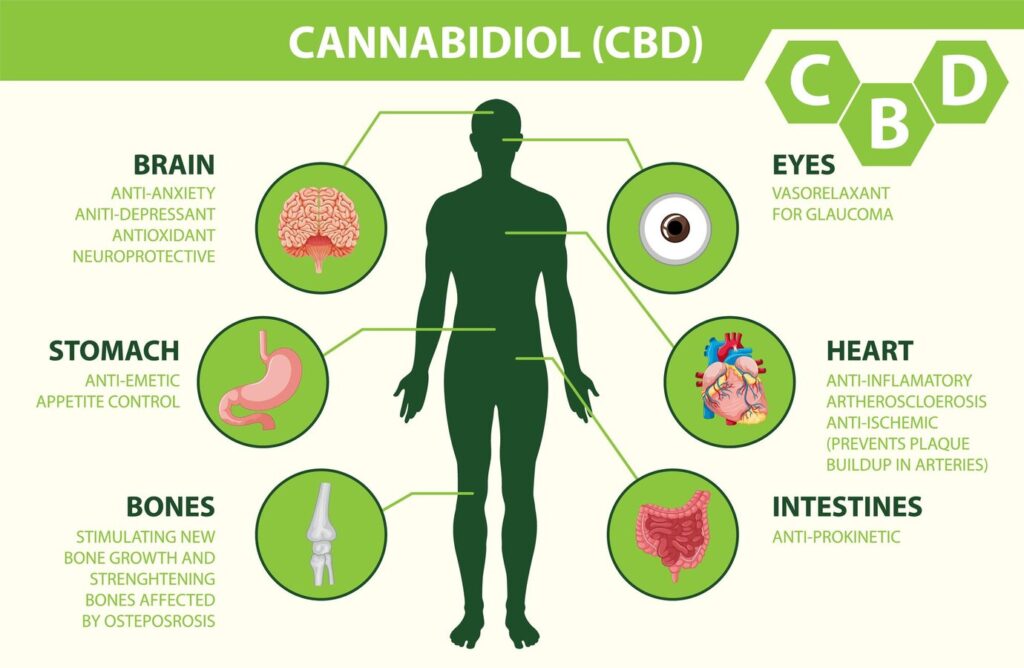Unlocking Localized Relief: How CBD Roll-Ons Interact with the Endocannabinoid System
CBD roll-ons have emerged as a popular and convenient way to target localized pain and discomfort. From soothing sore muscles after a workout to easing stiff joints, these topical solutions offer a direct approach to relief. But what’s the magic behind their effectiveness? The answer lies in how CBD Roll-Ons Interact with the Endocannabinoid System, a complex network within our bodies that plays a crucial role in regulating a wide range of functions.
This comprehensive guide will delve into the fascinating world of the Endocannabinoid System (ECS) and explore how the application of cbd roll on for pain can influence this system to provide targeted relief right where you need it most.
The Body’s Master Regulator: Understanding the Endocannabinoid System
The Endocannabinoid System is a vast and intricate network of receptors, endocannabinoids (naturally produced cannabis-like molecules), and enzymes that work together to maintain balance, or homeostasis, within the body. It’s involved in regulating crucial functions such as:
- Pain Perception: Modulating how we experience pain signals.
- Inflammation: Controlling the body’s inflammatory response.
- Mood and Stress: Influencing emotional states and the stress response.
- Sleep: Regulating sleep cycles.
- Appetite and Metabolism: Playing a role in hunger and energy balance.
- And much more!
The key components of the ECS include:
- Endocannabinoids: These are naturally produced molecules within the body, with the two main ones being anandamide (AEA) and 2-arachidonoylglycerol (2-AG). They bind to cannabinoid receptors to trigger various responses.
- Cannabinoid Receptors: The two primary cannabinoid receptors identified so far are CB1 receptors, mostly found in the central nervous system (brain and spinal cord), and CB2 receptors, predominantly located in the peripheral nervous system and immune cells.
- Enzymes: These proteins are responsible for breaking down endocannabinoids after they’ve served their purpose, ensuring the ECS remains balanced.
Topical Application: How CBD Roll-Ons Engage the Endocannabinoid System
Unlike ingested CBD products that enter the bloodstream and interact with the ECS throughout the body, CBD Roll-Ons Interact with the Endocannabinoid System primarily at the site of application. When you apply a CBD roll-on to your skin, the CBD molecules don’t necessarily penetrate deep enough to enter the bloodstream in significant amounts. Instead, they primarily interact with the ECS components present in the skin itself and the underlying tissues.
The skin is actually rich in cannabinoid receptors, particularly CB2 receptors, which are heavily involved in immune function and inflammation. There are also other receptors and enzymes of the Endocannabinoid System present in the skin, making it a prime target for topical CBD applications.
The Indirect Dance: How CBD Influences the ECS Topically
It’s important to note that CBD’s interaction with the Endocannabinoid System is somewhat indirect, especially when applied topically. Unlike THC, which binds directly to CB1 and CB2 receptors, CBD doesn’t have a strong binding affinity for these receptors. Instead, it’s believed to influence the ECS in other ways:
- Inhibiting Endocannabinoid Breakdown: One of the primary ways CBD is thought to work topically is by inhibiting the enzymes that break down endocannabinoids like anandamide. By slowing down the degradation of these naturally produced molecules, CBD may help to increase their levels in the local area, leading to enhanced activation of cannabinoid receptors.
- Interacting with Other Receptors: CBD can also interact with other receptors in the skin and nervous system that are involved in pain and inflammation. For example, it can interact with TRPV1 receptors, which play a role in pain and temperature sensation.
- Potential for Localized Effects: This indirect interaction with the Endocannabinoid System allows CBD roll-ons to exert localized effects on pain and inflammation without the widespread systemic effects that can sometimes occur with other forms of CBD consumption. This targeted approach is a key advantage for those seeking relief in specific areas of the body.
Benefits of CBD Roll-Ons Through Endocannabinoid System Interaction
By interacting with the Endocannabinoid System in the skin and underlying tissues, CBD roll-ons can potentially offer several benefits:
- Localized Pain Relief: By influencing pain signals and potentially reducing inflammation in the applied area, CBD roll-ons can help alleviate muscle soreness, joint pain, and other localized discomfort.
- Reduced Inflammation: The interaction with CB2 receptors and other pathways can help modulate the inflammatory response in the targeted area, potentially easing swelling and redness.
- Easing Muscle Tension: By promoting relaxation and potentially influencing nerve activity, CBD roll-ons may help to reduce muscle spasms and tension.
Factors Affecting the Interaction with the Endocannabinoid System

The effectiveness of a CBD roll-on and its interaction with the Endocannabinoid System can be influenced by several factors, including:
- Concentration of CBD: Products with a higher concentration of CBD may have a greater potential to interact with the ECS.
- Presence of Other Ingredients: Ingredients like terpenes can enhance the absorption of CBD through the skin, potentially leading to a more pronounced interaction with the ECS.
- Individual Differences: The density and activity of ECS receptors can vary from person to person, which may affect how they respond to topical CBD.
- Quality of the Product: The quality of the CBD extract and the overall formulation of the roll-on can significantly impact its effectiveness.
Conclusion: Harnessing the Power of the Endocannabinoid System with CBD Roll-Ons
CBD Roll-Ons Interact with the Endocannabinoid System in a fascinating and beneficial way. By primarily engaging the ECS components present in the skin and underlying tissues, these topical solutions offer a targeted approach to pain relief and inflammation reduction. While the interaction is largely indirect, CBD’s ability to influence endocannabinoid levels and interact with other relevant receptors makes it a valuable tool for localized wellness. By understanding this intricate relationship, you can make more informed choices about using CBD roll-ons to support your body’s natural ability to find balance and relief.
Frequently Asked Questions (FAQ)

1. How does the Endocannabinoid System (ECS) in my skin differ from the ECS in the rest of my body when it comes to CBD roll-ons?
The Endocannabinoid System in the skin has a higher concentration of CB2 receptors, which are primarily involved in immune function and inflammation. While CB1 receptors are more prevalent in the central nervous system, they are also present in the skin. CBD roll-ons primarily interact with these ECS components locally at the application site, without necessarily affecting the entire system to the same extent as ingested CBD.
2. Can CBD roll-ons directly activate the Endocannabinoid System to relieve pain?
While CBD doesn’t strongly bind to CB1 or CB2 receptors like THC, it’s believed to indirectly influence the Endocannabinoid System by inhibiting the breakdown of naturally produced endocannabinoids and interacting with other receptors involved in pain and inflammation. This indirect action can lead to localized pain relief.
3. If CBD roll-ons don’t enter the bloodstream significantly, how do they interact with the Endocannabinoid System to provide relief?
The skin itself contains a network of Endocannabinoid System components, including receptors and enzymes. When you apply a CBD roll-on, the CBD interacts with these local ECS elements in the skin and underlying tissues. This interaction can help modulate pain signals and reduce inflammation in the specific area of application.
4. Are there any specific types of pain where the interaction of CBD roll-ons with the Endocannabinoid System is most effective?
CBD roll-ons are often reported to be effective for localized pain such as muscle soreness, joint pain (like in arthritis), and potentially even some types of nerve pain. The interaction with the Endocannabinoid System in these areas can help reduce inflammation and modulate pain signals directly at the source of discomfort.
5. How can I ensure my CBD roll-on is effectively interacting with my Endocannabinoid System for the best results?
To maximize the interaction of your CBD roll-on with your Endocannabinoid System, choose high-quality products from reputable brands that clearly state the CBD concentration. Look for products that may contain ingredients to enhance skin absorption (like terpenes). Apply the roll-on to clean skin and gently massage it into the affected area to help the CBD reach the local ECS components.







